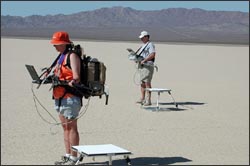
Landsat data have helped to improve our understanding of Earth.
Thanks to Landsat, today we have a better understanding of things as diverse as coral reefs, tropical deforestation, and Antarctica’s glaciers.
The 30 m spatial resolution and 185 km swath of Landsat imagery fills an important scientific niche because the orbit swaths are wide enough for global coverage every season of the year, yet the images are detailed enough to characterize human-scale processes such as urban growth, agricultural irrigation, and deforestation.
By establishing baseline knowledge of Earth’s land areas over the last half century, Landsat allows scientists to evaluate environmental change over time. Often, this baseline knowledge is represented in the form of a map.
Landsat and cartography have a long history. In July of 1972, Dr. Paul Lowman, a pioneer of the Earth remote sensing concept at NASA’s Goddard Space Flight Center, drew the first map from a Landsat image.
Since that time, Landsat-derived maps have been used to aid in navigation of poorly charted areas (especially in the Arctic and Antarctic, where Landsat data were used to find unknown mountains in southern Victoria Land and at the head of the Lambert Glacier).
Landsat images have also been used to map faults and fracture zones. Landsat information has served as the basis for a series of tectonic activity maps, the first in 1977, the latest in 2003. Data have also been used to find unmapped volcanic fields.
The science of remote sensing itself has matured with the Landsat project. Many developments in Earth-observation from space, such as the Terra observatory, can be traced back to the Landsat program.
Articles about Landsat’s scientific role.
Find out about the applications of Landsat data.
